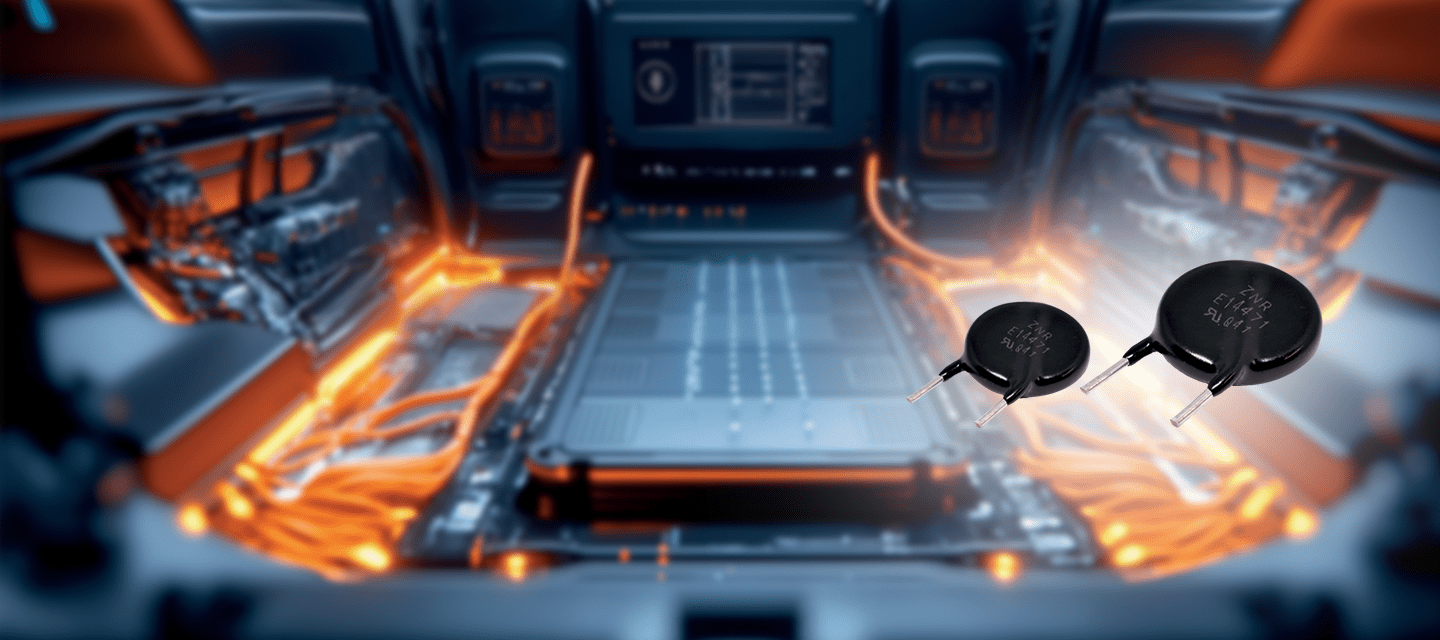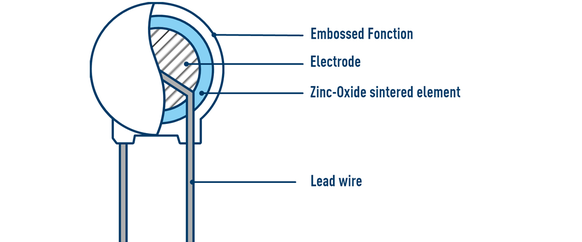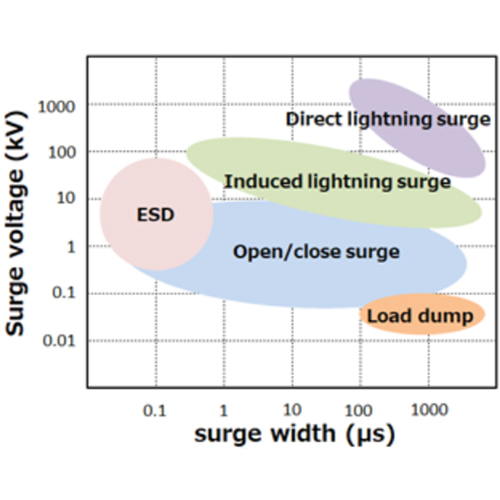
ZNR surge absorbers
What is a ZNR® (Zinc oxide Non-linear Resistor) surge absorber?

"ZNR" stands for Zinc-oxide Non-liner Resistor, the product name of a voltage-dependent resistor developed by Panasonic in 1968. This product is generally called a Zinc Oxide (ZnO) varistor or Metal Oxide Varistor (MOV).
The ZNR has a voltage-current characteristics curve horizontally symmetrical with respect to the Y-axis with the curve rising as sharply as the curve of a Zener diode.
With such characteristics, the ZNR absorbs harmful surge voltage instantaneously to protect electronic equipment.
As a surge protection component, the ZNR is incorporated in office automation apparatuses, communication equipment, household appliances, automobiles, etc., and is used for various applications, such as protecting transmission cables.
Surge voltage absorption principle and its effects
Applying a surge voltage results in a surge current flow through a ZNR, which clamps down the abnormal voltage.
The ZNR has non-linear voltage-current characteristics. When a voltage exceeding the varistor voltage of the ZNR is applied, the current flowing through the ZNR increases exponentially.
This behavior can be used to absorb surge voltages, which could otherwise damage the circuit behind the ZNR.
Example of surge absorption capability (ZNR: 14 mm in diameter, 470 V varistor voltage)
Principal specifications of the “ZNR®” Surge Absorber
Principal specifications of the “ZNR®” surge absorber are shown indicating performance.
| Specification Items | Description |
| Varistor Voltage [V] | In principle, voltage value at both ends of a component when DC 1 mA is applied. This is the guideline value of voltage when varistor operates. |
| Maximum allowable circuit voltage [V] | Maximum value of the commercial frequency sinusoidal wave voltage effective value allowing continuous application, or maximum value of DC voltage. |
| Maximum restricted voltage [V] | When a surge voltage is applied, the voltage value restricted by the varistor is called restricted voltage, and an individual catalog lists the maximum restricted voltage as maximum value. |
| Surge current resistance [A] | This value indicates the level of surge current resisted by the varistor. |
| Safety Standard | For components subject to a lightning surge, each country specifies safety standards such as UL (USA), CSA (Canada), IEC (Europe), CQC (China), and the components meeting the standards must be used in that country. |
Whether the specification meets the presumed surge voltage/current and circuit voltage used is examined when selecting a “ZNR®” surge absorber.
Example of Using a “ZNR®” Surge Absorber
Surge types and surge protection components
Surge refers to transient high-voltage noise caused by lightning and switching, etc.
A surge, in many cases, appears as a high voltage that far exceeds the allowable voltage range of parts and equipment.
Such a sharp surge of voltage can break circuits and equipment instantaneously.
What we collectively call a "surge" is actually classified into several types according to the causes.
To prevent different types of surges, you need different surge protection components, respectively.
This article will discuss types of surges and surge protection components used against them.

Surge Types
The graph on the right shows pictorial images of typical surge voltages and their durations.
1. Lightning surge
Lightning as natural phenomenon contains a very large amount of energy.
A lightning surge can be grouped into direct lightning surges and induced lightning surges. Protection against a direct lightning surge is difficult, but protection against induced lightning is possible. Induced lightning is a high voltage surge induced by a relatively long wire such as power line or communication cable that is nearby a lightning strike.
2. Open/close surge
Open/close surge is a transient high voltage surge induced in a switch or relay during its on and off operation, particularly when turning off, which causes rapid current change and inductance of the circuit or wiring. Voltage generated by an open/close surge is very high, and in some cases, it generates spark, heat or radiates an electromagnetic wave caused by a large damping oscillation current generated by floating static capacitance of inductance and contact. This high voltage surge may cause a malfunction of an electronic circuit, and in some cases, lead to the destruction of a component.
3. Load dump
Load dump is a surge generated by cutting the battery connection off on an automobile. The most severe instance occurs when the battery connection is lost while the automotive engine is in operation and the alternator (battery charging generator) is charging the battery. The magnitude of surge voltage is determined by the alternator rotation speed and magnetic field excitation strength at the moment of cut off.
4. ESD (electrostatic discharge)
ESD (electrostatic discharge) is a phenomenon where a charge is stored in a small floating capacity on a human body or substance then discharged to a nearby object and is classified as one type of surge. ESD duration is short with little energy, but because it generates transient high voltage as high as several kilo volts, it can generate a malfunction of electronic circuits or damages electronic components.
Surge Protection Components
The following table shows the types of surges and Panasonic corresponding surge protection components.
These components have a high electrical resistance when the terminal voltage is low, but the resistance suddenly become low when the voltage drastically increases.
By using this tendency, the component prevents a surge from entering the circuit by bypassing the current.
| Surge type | Surge protection component | Remarks |
| Lightning surge (Induced lightning surges) |
ZNR surge absorber | Use different types (series) of surge absorbers for different line voltages (100 V to several kV) or different amounts of energy. |
| Open/close surge | ||
| Load dump | SMD type (HF series) | |
| ESD (electrostatic discharge) |
Chip Varistor | Applied mainly to signal lines transmitting signals in kHz/MHz frequency bands and to low-voltage power lines. |
| ESD Suppressor | Applied mainly to signal lines transmitting signals in GHz frequency bands. |




